
JUNE 24






GIRAFFE DAY 21ST JUNE 24
11 EDITIONS READ, BY OVER 152,000 RESIDENTS
•
•
•
SWANWICK • RIDDINGS
LEABROOKS
SOMERCOTES

We

Boiler Breakdowns
Boiler Servicing
Radiators & Pipes
Tanks & Cylinders
Toilets & Taps
Leaks & Bursts
Showers
Clearing Blockages
Pipework Replacement
Gas

Rightio Plumbers OAP Discount 1-2 Hour 01773 843 258
OUR SERVICES
650921
Month Speak to us today! Response time! guarantee on labour!
Response
Work Guaranteed
Experienced
Pricing
work in
Safe Certified
12
Fast
All
Highly
Clear
Swanwick, Riddings, Leabrooks,
all
areas OAP Discount 1-2 Hour 12 Month Speak to us today! Response time! guarantee on labour!
Somercotes &
surrounding
THE AWKWARDLY ELEGANT GIRAFFE
It may be just me but in the pantheon of weirdly designed animals, the giraffe has to be at, or near the top of the list.
Evolutionary theory tells us that they developed their extraordinarily long necks in order to reach the most succulent vegetation found at the tops of trees.
My simplistic brain can’t help but think…well why did they not just eat something lower down? And what did they eat before their necks stretched so much?
Don’t get me wrong, I have absolutely nothing against giraffes. In fact their faces are really rather appealing, all angles, big eyes and long, long eyelashes. They even have the equivalent of fingerprints as no two giraffes have the same coat pattern. But they just seem so blinking awkward!
It’s a wonder any baby giraffes survive the fall from mum’s…errr…rear end… to the ground. Given the fragile nature of the long newborn neck, it must be very easy for it to break in the event of a less than safe landing.
That fact alone has me amazed that the species managed to survive and evolve. And have you ever seen giraffes fighting?
Apparently they find it very difficult to lift their legs off the ground to kick out, which is what most ruminants would do. So, instead, they bash their necks together…really, really hard.
Honestly, they are so badly designed that their necks are too long for them to drink unless they splay their legs out before dipping towards the water source. I mean… really!
Their circulatory system also has to cope with the fact that their blood pressure dips dangerously low when they bend their head to drink. The jugular veins have developed incredibly elastic walls and large one-way valves that allow the veins to expand significantly and prevent the blood from flowing back to the brain when the giraffe’s head is lowered.
The poor creatures can’t even lie down for a proper kip either. They do “lie” down with their long legs tucked underneath them, but the neck is usually still upright. Occasionally, and only for very short periods of normally not more than 5 minutes, giraffe can sleep with their head resting back on their rump.
Five minutes sleeping!
I could not be a giraffe!
Joking apart, there is a serious side to this article – June 21 is World Giraffe Day – a day to remind us that giraffes are in fact an at risk species. There has been an almost 30% population decline over the past three and a half decades, leaving an estimated population of 117,000 individuals.
They may be ungainly and awkward, but they do deserve to be respected, cared for, and allowed to flourish, as does every other species on this planet we all call home.

These articles are researched and written by Laura Billingham, a local content writer and author. Laura moved to the Peak District several years ago to pursue her passion for writing. To find out more visit www.word-witch.co.uk or contact Laura on 07736 351 341


ALL EVENTS MEMBERS FREE, NON-MEMBERS TO PAY ON THE DOOR

1ST TUESDAY OF THE MONTH
Derbyshire Beekeepers Society from 7.30pm
1ST WEDNESDAY OF THE MONTH
Classic cars from 7/7.30pm
LAST FRIDAY OF THE MONTH
Sat 22nd June
Bar Open from 2pm
Bikers to meet at 3.30pm
Everyone welcome
Quiz night, £3pp including buffet
LAST SATURDAY OF THE MONTH
Northern Soul
2ND TUESDAY OF THE MONTH
Acoustic Night
For further details see our fb page South Wingfield Social Club Group

invite you to a
Saturday 22nd June 2024 from 12.00 noon to 2.00pm
Various meat & quiche salads & strawberry based desserts available
For Community Advertising Contact us on 01773 549035 NEWS • EVENTS • UPDATES • LOCAL INTEREST COMMUNITY NOTICE SOUTH WINGFIELD SOCIAL CLUB UP & COMING EVENTS...
EVERY MONTH LAUREN’S LEGACY MEMORIAL RIDEOUT BIRCHWOOD METHODIST CHURCH, SOMERCOTES
STRAWBERRY LUNCH








To advertise please call the Voice Team on 01773 549 035 7 R ROOFING SPE CIALIST 0OF CRAFT YOUR LOCAL ROOFING SPECIALIST ALL TYPES OF ROOFING SERVICES • BIG OR SMALL • NEW ROOFS RE-ROOFS • ROOF REPAIRS • FLAT ROOFING • CONSERVATORY ROOFS We are proud to have offered our services to the area for over 20 years building up our reputation by offering a high service at affordable, honest and reasonable prices to both residential and commercial customers. Many of our customers are return customers or gained through ‘word of mouth’ and we welcome this loyalty. 24 HOURS 7 DAYS A WEEK EMERGENCY REPAIR CALL OUT SERVICE 01773 464 127 • 01332 653 904 • 0800 8611 444 info@roofcraftspecialists.co.uk www.roofcraftservices.co.uk WITH OVER 20 YEARS EXPERIENCE “Whatever the weather we have you covered.” BEFORE BEFORE AFTER AFTER










SLEETMOOR LANE SPORTS GROUND, SWANWICK, ALFRETON, DE55 1RH WWW.SLEETMOORUNITED.CO.UK












10 Don’t forget to mention Voice Magazines when responding to the Ads TEL: 01773 811371 Email: info@wilkinsonbros.co.uk Web: www.wilkinsonbros.co.uk A completely professional 24 hour service, covering all areas Private Chapel of Rest in peaceful surroundings We will provide you with a personal and sympathetic service, looking after all your needs and wishes Pre-arranged Funeral Plans, tailored to your specific wishes, are available WILKINSON BROS LTD Est. 1952 Independent Family Funeral Directors Our Family Looking After Your Family CONTACT US T: 01773 861050 • E: info@renshawmortgagesolutions.co.uk www.renshawmortgagesolutions.co.uk 25 Main Road, Jacksdale, Nottingham. NG16 5JU Your home may be repossessed if you do not keep up repayments on your mortgage. Typically we charge a fee of £399 for arrangement of your mortgage, however the actual fee will not exceed 1.5% of the mortgage amount. The fees may be waived subject to the terms of the fee waiver agreement. MORTGAGE FOR YOU FINDING THE THAT’S RIGHT Your local, independent mortgage brokers Professional Services ALLOYS REFURBISHMENT & VALETING SERVICE Get in touch now for your free quotation! We also remove small body work scratches. Professional valeting service available. Curb Scuffs • Scraps & Chips • Professional Alloy Wheels Refurbishment • All Work Guaranteed • Refurb or Colour Change T: 0 7 9 6 9 9503 0 1 E: j tech.al l o y s@ o ut loo k . c o m









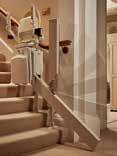

PROFESSIONAL SERVICES To advertise please call the Voice Team on 01773 549 035 11 An amazing life, deserves amazing care. Ear, Eye & Skin Care Disease Management Vaccinations Breeder Services Senior Pet Care & much more... Treating Pets as Family www.vetcarehome.co.uk 01773 302 220 Specialists in end of life care. Find out more As specialists in end of life care, our caring team strive to ease the toughest process for pet owners. - ensuring you and your pet receive the utmost care and respect. Our other services include... ■ Local, family-run business ■ Almost 20 years’ experience ■ New, reconditioned and rental available ■ Friendly, personal service ■ Free, no obligation survey ■ 24/7, 365 days call-out ■ Repair and service all makes of stairlifts ■ Members of Age UK Local Installation, Repairs and Servicing of Stairlifts Contact Sarah on 0115 849 2386 @Prioritystairlifts /prioritystairlifts info@prioritystairlifts.co.uk www.prioritystairlifts.co.uk








For Community Advertising Contact us on 01773 549035 NEWS • EVENTS • UPDATES • LOCAL INTEREST Welcome to YOUR community noticeboard. A dedicated space for you to post notices, events and for not-for-profit community groups to advertise in. Contact us on 01773 549035 or community@voicemagazines.co.uk EVENT TITLE Date & Time Contact Contact Contact 44mm 44mm £6.30 +VAT Per Square

RASCALS CELEBRATE LIFESAVING SUCCESS

As the 2023/2024 competitive Lifesaving season comes to an end, RASCALS has emerged as a formidable force, capping off an outstanding season with a string of impressive results. The list of competitions targeted has been extensive:
✔ Yorkshire Speeds
✔ Holland National Championships
✔ Royal Life Saving Society (RLSS) Nationals
✔ Surf Life Saving GB (SLSGB) Open Nationals
✔ British Universities Life Saving Clubs’ Association (BULSCA) Nationals
✔ Welsh Nationals
✔ Irish Nationals
✔ Surf Lifesaving GB (SLSGB) Youth Nationals
✔ Spanish Nationals

At the Yorkshire Speeds, RASCALS had a stellar performance, clinching the top spot on both the points and medal tables. Continuing their winning streak, the club excelled at the Welsh Nationals in Swansea, securing the highest number of medals and finishing a close second in overall points. This performance was mirrored in Birmingham at the RLSS Nationals where RASCALS again claimed the top spot on the medal table and a commendable second place in points. The BULSCA Nationals witnessed another strong showing from the club, as they clinched second place in the medal table. SLSGB welcomed the club to Cardiff where two days of competition resulted in 2nd place on the points, top of the medal table in the Youth category and 3rd place on points in the Open category.
RASCALS enthusiastic junior lifesavers showcased their talent and potential at the Leeds Rookie Festival and the short course Billingham competition, achieving personal bests and winning medals along the way, ensuring a promising future for the club.
The club’s achievements extended beyond national borders, with several RASCALS lifesavers triumphant in representing Great Britain at the European Lifesaving Championships and representing England, Scotland and
Wales at the Commonwealth Lifesaving Championships in Canada. RASCALS is now host to a talented top-tier of international medallists, not least international gold medallists!
Overall, RASCALS won 83 National titles, 62 Silver medals and 49 Bronze medals and set 8 national records.
Expressing his pride in the squad’s performance, Head Coach Daniel Woodthorpe highlighted the tireless efforts put in by the athletes, their supporters and all the volunteer coaches and manager, remarking that “yes, it has indeed been a fantastic season!”. Recognizing his commitment to the sport and in addition to his GBR coaching responsibility, Daniel has just been appointed joint Team Manager/Coach for Team England at the Commonwealth Championships taking place in Swansea 2025. Congratulations!
Looking ahead, the focus now shifts to the Bridlington beach training day and Traditional lifesaving competitions where lifesavers are encouraged to develop and maintain the essential physical and mental skills to save lives. We wish RASCALS lifesavers further success in the upcoming season.
If you would like to expand your swimming activities or try something new, please contact us. contact@ripleyrascals.org.uk • www.ripleyrascals.org.uk



HEALTH & BEAUTY 14 Don’t forget to mention Voice Magazines when responding to the Ads
MOBILE FO OT CLINIC
S & K Doher ty

DipCFHP MPSPract
Over 10 years experience



• Nail trimming & reduction
• Hard skin reduction
• Corn removal

Problematic conditions including:
•Nails Trimmed reduced
• Callus reduction
• Corn removal
Day & Evening
Appointments Available
• Verruca treatment
• Diabetic advice
To arrange an appointment please call: IN BUSINESS FOR 10 YEARS
Prices from £17





HEALTH & BEAUTY MOBILE FOOT HEALTH PRACTITIONER
K E E P I N T O U C H W I T H U S O N O U R S O C I A L M E D I A : @ G L E N D A I R D E N T A L P R A C T I C E @ G L E N D A I R F A C E S I N F O @ G L E N D A I R D E N T A L . C O . U K C A L L 0 1 7 7 3 8 3 2 1 6 4 L I M E S A V E N U E , A L F R E T O N , D E 5 5 7 D W D E N T I S T R Y A N D F A C I A L A E S T H E T I C S A T G L E N D A I R W W W . G L E N D A I R D E N T A L . C O . U K
AMBER VALLEY RUGBY CLUB
A SEASON TO REFLECT ON...

Despite encountering challenges, the senior squad of Amber Valley Men showcased resilience and determination this season, earning respect on and off the field. Their growth as a cohesive unit was evident in each game, with valuable lessons learned from every experience. Looking ahead to the 2024/25 season, excitement brews within the club as pre-season training commences on July 8th at 7 pm. Those interested in joining can contact Stuart at 07966 867 946


Amber Valley Tigers celebrated a successful season, clinching the league championship with a 36-14 victory against Barkers Butts in their final game. Despite a loss in the national cup semi-final to the reigning champions, they’ve thrived, even recruiting six new players. The NLD cup final awaits on May 26th. To be part of this successful and welcoming team, contact Gareth at 07595 520 537
Amber Valley Rugby Mini and Juniors concluded their season with a memorable festival, showcasing talent and teamwork. Young athletes displayed passion for the game, forming friendships and making memories. As the tournament ended, it marked the beginning of a lasting love for rugby among many. For those interested in joining, contact Paul at 07790 403 043.
More than just a club, we are the #ValleyFamily. You can visit our website www.ambervalleyrfc.co.uk, Facebook & Instagram pages to contact us or follow what we do. You can find us at Lower Somercotes, Somercotes, Alfreton DE55 4NQ





16 Don’t forget to mention Voice Magazines when responding to the Ads HEALTH & BEAUTY LARGE SOFA & CARPET SHOWROOM QUALITY AT AFFORDABLE PRIC ES 0115 9300050 www.richdalesofas .co.uk Visit our Showroom –The Old Co-op, Market Place, Ilk eston DE7 5GF
Food & Retail Ken & Kenny Bexton father & son team A1locksmithslIMITED.co.UK a1locksmithsltd@yahoo.co.uk call us today on: 07977 432 089 A1 Locksmiths ltd UPVC specialists 34 Peveril Drive, Riddings, DE55 4AP



Life's too short for ordinary holidays. With our all-inclusive escapes, the only thing you'll need to worry about is which cocktail to try next.
Whether you’re craving the sun-kissed shores and Mediterranean charm of Greece or the idyllic beaches and tropical luxury of the Maldives, dive into our all-inclusive packages and unlock a world of adventure, relaxation, and gourmet delights.
Contact me for a copy of my latest digital brochure and please get in touch if any of the all-inclusive holidays featured catch your eye. Let me take care of the details while you focus on making memories that last a lifetime!



To advertise please call the Voice Team on 01773 549 035 17 01773 318540
travelcounsellors.com/mandy.oldknow
mandy.oldknow@mytc.com
Oldknow T R A V E L C O U N S E L L O R
Mandy
All Inclusive

COACH TOUR HOLIDAYS
WARNER LEISURE
Heythorp Park, Cotswolds
Mon 1st - Fri 5th Jul
5 Days - £645
PORTHCAWL
Seabank Hotel
Wed 10th - Sun 14th Jul
5 Days - £465
SOUTHERN SUMMER SPECTACULAR
IHG Voco Hotel, Reading
Thu 25th - Mon 29th Jul
5 Days - £599
TORQUAY
Livermead House Hotel Tue 6th - Sun 11th Aug
6 Days - £599
SOMERSET
Mercure Hotel, Bridgwater
Thu 8th - Mon 12th Aug 5 Days - £545
SOUTHPORT FLOWER SHOW
Mercure Hotel, Heydock Sun 18th - Mon 19th Aug 2 Days - £170
PHONE: 01773 590 808 01246 604 764 or 07483 357 958 Go online WWW.CLAIRSCOACHES.CO.UK NEW BOOKING OFFICE: Parkvilla,124 Market Street, Clay Cross, Derbyshire S45 9LY FOR A 2024 BROCHURE OR TO BOOK:


ISLE OF BUTE
Glenburn Hotel Sun 25th - Fri 30th Aug 6 Days - £650
ISLE OF WIGHT
Burlington Hotel Mon 26th Aug - Mon 2nd Sep 8 Days - £625
WILTSHIRE WARNERS
Littlecote House Mon 26th - Fri 30th Aug 5 Days - £475 (Halfboard)
MOBILE BOOKING OFFICE LOCATIONS
2nd Tuesday of each month 9am - 1pm | South Normanton Market Place
2nd Thursday of each month 9.30am - 12.00pm | Bolsover Market
2nd Friday of each month 9am - 1pm | Ripley Market Place




3rd Thursday of each month 9am - 1pm | Alfreton Severn Square Car Park (Outside B&M)
3rd Friday of each month 9am - 1pm | Sutton-in-Ashfield, Portland Square





FOOD & RETAIL 18 Don’t forget to mention Voice Magazines when responding to the Ads
Local Pick Up Points
ALL HALF BOARD INCLUDING EXCURSIONS & ENTERTAINMENT! DOORTODOOR PICKUP!
Local Pick Up Points
Blind Screen Made to Measure Curtains Planation Shutters email:premiersales@hotmail.co.uk | www.premierblindsandcurtains.co.uk To book a home visit CALL 01773 771 457 | 07942 046 477 30 YEARS EXPERIENCE Venetian Blinds Curtain Poles/Tracks Perfect Fit Vertical Blinds Roller Blinds Roman Blinds

Slimming World Recipe
Sticky chicken drumsticks and chips with American-style salad
Method:
1. Put the chicken, spices and 1 level tbsp sriracha in a large bowl. Mix everything together using your hands, until the chicken is evenly coated. Cover and chill for at least 1 hour, or overnight.
2. Preheat your oven to 200°C/fan 180°C/gas 6.
3. Spread the chips out on a large, non-stick baking tray in a single layer and spray with low-calorie cooking spray. Spread the drumsticks out on another non-stick baking tray. Put the chips on the shelf below the chicken and cook for 20 minutes, then turn

everything and swap over the trays. Cook for a further 20 minutes, or until the chicken is cooked through.
4. At the same time, toss together the celery, cucumber, lettuce and radishes. Mix the yogurt with the chives, lemon juice and garlic granules, and season lightly.
5. Stir the yogurt dressing through the salad and scatter over the reserved chives. Brush the remaining sriracha evenly over the chicken. Serve 2 drumsticks per person with the chips and salad
For more information visit www.slimmingworld.co.uk






Summertime makes us think of eating al fresco whilst soaking up the sun. With a mix of spicy sticky chicken, light crispy chips and cool tasty salad, this dish is perfect for those chilled out days ahead.
Ingredients:
• 8 chicken drumsticks, skin and visible fat removed, flesh scored
• 2 tsp smoked paprika
• ½ tsp ground allspice
• 2 level tbsp sriracha
• 800g floury potatoes, such as Maris Piper or King Edward, cut into chips
• Low-calorie cooking spray
Serves: 4 Syns per serving: 1/2




For the salad:
• 4 celery sticks, chopped
• 1 cucumber, halved lengthways, deseeded and sliced
• 2 little gem lettuces, shredded
• 200g radishes, chopped
• 200g fat-free natural yogurt
• ½ small pack fresh chives, chopped, reserving some to serve
• Juice of 1 lemon
• ½ tsp garlic granules
Ready in: 55 minutes (plus 1 hour to marinade)








EVERY SATURDAY 7:00am, 8:30am & 10:00am ST JOSEPHS CHURCH

Community Hall, Butterley Hill, Ripley, DE5 3LT

VENUE ACCESSIBILITY




TUES MORNING - 9.30am
SOMERCOTES VILLAGE HALL



Wheelchair access • Disabled toilet • Disabled parking
TUESDAYS - 3:30pm, 5:00pm & 6:30pm


SHIRLAND VILLAGE HALL


Main Road, Shirland, Alfreton, DE55 6BB





Nottingham Road, Somercotes, DE55 4HQ

WED MORNING - 9am
PALMER MOREWOOD MEMORIAL CLUB 36 Hall Street, Alfreton, DE55 7BU

WED EVENING - 6pm
CHRIST THE KING CHURCH HALL
Nottingham Road, Alfreton, DE55 7GL






FRIDAY MORNING - 8am & 9.30am

SELSTON PARISH HALL

Mansfield Road, Selston, NG16 6EE

Sue: 07738 118 130



FOOD & RETAIL To advertise please call the Voice Team on 01773 549 035 19
slimmingworld.co.uk slimmingworld.co.ukslimmingworld.co.uk
Heidi: 07534 688 178 slimmingworld.co.uk slimmingworld.co.ukslimmingworld.co.uk






FOOD & RETAIL 20 Don’t forget to mention Voice Magazines when responding to the Ads END OF THE LINE FACTORY SHOP Est. 1987 FURNITURE UPHOLSTERY & RE-UPHOLSTERY REPAIRS All work carried out by our own skilled craftsmen with over 20 years of experience Home visits a pleasure for a FREE QUOTATION for re-upholstery or furniture repairs. Opening times: Tues - Fri: 10am - 5pm • Sat: 10pm - 3pm MOBILE: 07960 849 642 PINXTON CARPETS & BEDS CARPETS VINYLS BEDS BLINDS 81 WHARF ROAD, PINXTON NG16 6LH TEL 01773 811878 OPEN TUE-SAT 9am-3pm See pinxtoncarpets.com for latest offers SOLID OAK FURNITURE AT CLEARANCE PRICES CELEBRATING 25 YEARS OF LOW PRICES LET US QUOTE BEFORE YOU BUY! half price beds ma�resses� �ooden beds and divans at around 50% off RRP carpet warehouse carpet remnants vinyl flooring measuring � ��ng










FOOD & RETAIL To advertise please call the Voice Team on 01773 549 035 21 HOME IMPROVEMENTS ROOFING PLASTIC VERGES SOFFIT & FACIAS REPOINTING OF WALLS & BUILDINGS BUILDING MAINTENANCE CALL STEVE ON 07717 252 896 Home Improvements Tailoredblinds&curtains FREEHOMESURVEY"ATION Chooseyournewblinds&curtainsfromthecomfortof yourownhomewithourfreehomesurveyorvisit ourshowroom(Just2minsfromIKEA) sa les @ k acox.co.uk 017 73 712888 k acox.co.uk WALKERS PLUMBING & LOCKSMITHS Emergency Plumbing General Plumbing Repairs Showers and Bathrooms Emergency Locksmith 07816 84 05 90 Night or Day We’re On Our Way Since 2001
Alfreton & District Heritage Trust
JUNE 2024
EARLY INDUSTRY IN ALFRETON

When I started looking at this month’s topic, I thought I’d research the history of another street in Alfreton and so my attention was drawn to the “bottom end” of Alfreton and Park Street in particular. Having had the odd pint or two in the Miners Arms in my younger years (and sadly having the misfortune to have been locked in on several occasions!) it was a natural choice.
Park Street, however, isn’t all that it seems. Originally it had the ancient name of the Ropewalk and was associated with the ancient craft of Rope Making. Certainly, we know both Alfreton and Swanwick had Rope Houses where rope was produced. Alfreton was renowned for the quality of its rope, particularly that produced for the many pits in the area.
Hemp was required to produce rope and the earliest records I have found of its existence in the Parish of Alfreton dates back to 1698 with a further reference in 1744. In September 1810, the Terriers of St. Martin’s Church also mention that The Skinner Hill Pingle was to be known as Rope House Close.
One family closely associated with ropemaking in Alfreton for many years were the Fell family who had premises on King Street. The business began around 1800 when Mr Marshall Fell, a Farmer and Ropemaker from Warsop, moved with his family from the Nottinghamshire village. The business then passed to his son, Samuel, and then to grandson, Marshall Fell. When Marshall Fell died on 16th July 1888 the business passed to his son Harry Fell.

The Fell family made rope in the traditional way using the band

system of rope making just as their ancestors had always done in the years before them in what is known as the “ropewalk”. A piece of land which derives its name from the pedestrian exercise which the old system of rope making entailed. Harry Fell was joined in the business by his son, Harry Marshall Fell and the business was extended to include the manufacture of covers, stack cloths, horse rugs etc.
Harry was well known within the farming community and within the local church community being a keen campanologist. He was a bell ringer at St Martin’s Church for over 40 years and following his death in 1925 was buried there. Sadly, the family business was to close around seven years after his death.
If you are interested in learning more about local history then pop along to Palmer Morewood Social Club between 10am and 3pm on Saturday, 15th June when we have a Heritage Day featuring many local groups and live music from The Amber Band. Refreshments will be available.



POP OVER TO OUR WEBSITE TO SEE MORE ABOUT THE ALFRETON HERITAGE SOCIETY ON WWW.ALFRETONANDDISTRICTHERITAGETRUST.WORDPRESS.COM
Harry Fell
Fells Rope Makers Shop King St



















HOME IMPROVEMENTS Colemans Est 1982 KITCHENS AND BEDROOMS LTD Colemans have been manufacturing bespoke kitchen and bedroom furniture for over 40 years We are a family run business with a belief in great quality products and service at sensible prices All our products are built specifically for you and your needs, we can manufacture in any colour and style your heart desires With Colemans the possibilities are endless Visit our showroom 178 Victoria Road, Kirkby in Ashfield, Nottinghamshire, NG17 8AT Tel: 01623 751239 ǁ Web: colemanskitchensandbedrooms.co.uk Tel: 0800 303 2072 • Mob: 07842 891 325 Get in touch TODAY for a FREE no obligation quotation No Job TOO Big or small Find us on checkatrade From guttering to complete roofs• Quality workmanship Value for money • Honest advice IS YOUR ROOF OVER 40 YEARS OLD? HAS THE ROOFING FELT EVER BEEN REPLACED? CALL US TO FIND OUT MORE

Flake’ s Favourites
Re-walking Rafa’s Rambles

So Summer is about to arrive and if you’re anything like me you’re more than ready for it! Whilst our furry friends need a walk whatever the weather, it’s a lot nicer when it’s not quite so grotty. This month’s walk sets off from the village of Scarcliffe. It’s a lovely, varied walk that makes use of some paths in the nearby woods allowing you to explore this lesser seen part of this beautiful area.
6-MILE CIRCULAR WALK FROM SCARCLIFFE
A mid distance walk which should take you and your dog around 2½-3 hours to complete. The walk is mostly on trails and paths but there may be some uneven and muddy terrain, particularly with inclement weather so please wear appropriate footwear. There is also a couple of roads to cross and one short section of road to walk along, so please take plenty of care. As always, follow the countryside code, keeping dogs on leads where appropriate.



START: CHURCH OF SAINT LEONARD, SCARCLIFFE. S44 6TE
1. Standing with your back to the church turn left and continue along the road. After a short distance and just prior to a road on your right, turn right onto a lane and signposted footpath to thread between the houses. At the end of the lane/driveway continue straight ahead onto a footpath. After a very short distance, ignore the stone stile on the right and climb over the stone stile in front of you.

2. Now continue straight ahead and walk along the edge of a field with a hedge on your right. After some distance follow the footpath sharp right and immediately cross over a stone bridge. Now continue straight ahead to cross a field with a hedge on your left.


24 Don’t forget to mention Voice Magazines when responding to the Ads M o n to Fr i – 9 a m – 4.30 p m S at – 8 : 3 0 a m – 12 p m Seals Fodder Room, The Mill, High Street, Swanwick, Derbyshire Sponsored by

3. After some distance continue along the footpath with a hedge on both sides and then cross over a wooden footbridge. Now continue straight ahead going gently uphill into some trees. After a short distance you will reach a lane. Turn right onto the lane and pass a marker post on your right and continue straight ahead.
4. Continue straight ahead for a short distance and then the lane splits into two. Take the left split and then curl around to the left to continue along a lane with trees on both sides. After a long distance you will continue straight ahead with trees on your left and open views to the right.
5. Continue until eventually reaching a road. Turn right along the road for a short distance and then turn right again along ‘Common Lane’. After a short distance and at a bus stop on your left bear slightly left onto a footpath running parallel with the road. Then after some distance the path comes back alongside the road.
6. Continue along the road for a long distance, passing an academy on your left. After passing the academy and upon reaching two no entry signs on your left, turn right along a lane and signposted footpath on your right.
7. After a short distance pass by a large gate and then continue with a hedge on both sides. Continue for a long distance until reaching a footpath on your left which is marked by a marker post on your left. Immediately after the footpath on the left and at a junction of lanes bear to the right and then continue straight ahead with a hedge on your left and trees on your right.

8. Continue along this lane for a long distance and eventually reaching a T junction of lanes. Turn left at the T junction and continue along a lane. After a short distance ignore a lane on your right and continue straight ahead along the lane heading into the trees.
9. Eventually the lane begins to climb steeply. At the top of the hill the lane splits into two. Take the lane on the right and continue straight ahead heading through the trees. After some distance you will pass by a gate and come out of the trees to a T junction of paths. Standing with an open field in front of you turn right and continue along a footpath with trees on your right and open views on your left.
10. Continue straight ahead and you will begin to drop downhill. At the bottom of the hill upon reaching a small fence directly in front of you, turn right, continue for a very short distance and then pass through a gap in the fence. Turn immediately left, ignoring the path going downhill through the trees, continue straight ahead for a very short distance, and then turn right to continue downhill through an open field.
11. At the bottom of the hill cross over a small wooden footbridge and bear left. Then head diagonally right, heading uphill and through the woods. Keep to the path for some distance to reach a gate.
12. Pass by the gate to join a lane. Continue straight ahead with a hedge on both sides. After some distance you will pass through a small metal swing gate adjacent to a large metal gate. Continue straight ahead until reaching a road.
13. Turn right along the road heading downhill and back into the village of Scarcliffe. Eventually you will reach the church.


This walk is for illustrative purposes only. Voice Magazines Ltd takes no responsibility for anyone who chooses to follow this route and encourages all walkers to obey all byelaws and signs and to respect the area they are walking in, ensuring they pick up all dog mess and obey the countryside code at all times.

PET SERVICES To advertise please call the Voice Team on 01773 549 035 Call us on 01773 602 466 ww w. s e a ls fo d d e r.c o.u k
BOLSOVER
PALTERTON
Stony Houghton
Elmton
Upper Langwith














HOME IMPROVEMENTS 26 Don’t forget to mention Voice Magazines when responding to the Ads Considering changing your bathroom? VISIT our SHOWROOM IN RIDDINGS for inspiration & expert advice • Shower rooms & Ensuites • Bathroom Furniture & Storage • Easy Access Bathrooms • Tiles, Mirrors & Taps • Full Bathroom Suites • Space Saving Ideas www.metrobathrooms.co.uk Tel: 01773 318 008 • Email: info@metrobathrooms.co.uk Unit 1, Windmill Business Park (offGreenhillLane), Mill Lane, Riddings, DE55 4DB (oppositeWindleaRoad) Opening Hours: Mon to Thurs - 9:00am until 4:00pm SERVICE THE TRADE AS WELL AS PUBLIC OPENING TIMES MON - THURS 9AM - 4PM B6016 SHAWSTREET MILLLANE WINDLEAROAD GREENHILL LANE GREENHILL LANE METRO BATHROOMS THERED LION GRILLCHARCOAL TRADE PUBLIC OUR SHOWROOM IS OPEN TO & BUSINESS EST SINCE 2015 COME & SEE OUR UPDATED DISPLAYS

All Around the Shire
THE RECKITT’S COMPANY
I have recently acquired a magnificent piece of social history: a Reckitt and Sons vintage demonstration box of the type used by travelling salesmen. It contains sample items of many of the products Reckitt’s made. Their earliest creation was laundry starch in 1819. The dolly blue bag and black lead followed in 1852. It is now a worldwide company.


Alongside the dolly blue bag is a “cream tint” bag. We have asked many people through our social history talks, and no one is able to remember the red and cream bag or knows what it was for.
We would welcome any information on this item. One of my favourite products was, and still is, Windowlene -pink and fragrant, smeared on your glass would bring your windows up a treat, polished to a shine with newspaper.
Reckitt’s has been at the forefront of health and household products for two hundred years, developing brands like Dettol, Steradent, Harpic and Strepsils.





For me, the smell of Brasso particularly brings back memories of my father polishing his army buttons and buckles. He was a regular in the Sherwood Foresters and is still as well turned out as ever. He used to sing a song about “Shine up your buttons with Brasso” but only the clean version! My husband, Paul, learned the other version in the school cadet corps.


When we show this very special item at our presentations, it elicits warm and fond memories of familiar items we have grown up with and will continue to grow old with.
Janet and Paul Barrass are All Around the Shire. Find us on or email: oldfield512@btinternet.com for more information.





HOME IMPROVEMENTS To advertise please call the Voice Team on 01773 549 035 27
Janet EST SINCE 2015 ARE YOUR TILED AREAS LOOKING GROTTY? Call, Whatsapp or text Phillipa on 07939 245 005 tiledoctorderbyshire@gmail.com www.derbyshire.tiledoctor.biz The Tile, Grout & Stone Restorer. WE OFFER… • Tile and Grout Cleaning and Sealing. • Grout Recolouring - looks like new! • Sanitary Silicone removal & replacement. • Stone Tile Cleaning & Sealing to showers /baths. • Stone fireplace Cleaning and Sealing. • Free no obligation quotes Windows D oors and C onservatories Fas cia a nd Soffits, B i- fold D oors Mi sted / B roken G lass u nits Ge neral s ervicing e tc. Dan Kelly 07920 146983 dan-kelly26@hotmail.co.uk www.dankelly-windows.co.uk WINDOWS & DOORS Ltd Call Derek Bonser 07812 995 634 • 01773 302 222 info@ripleyrubberoofing.co.uk www.ripleyrubberoofing.co.uk RIPLEY RUBBER ROOFING 20 YEAR WARRANTY













HOME IMPROVEMENTS 28 Don’t forget to mention Voice Magazines when responding to the Ads Re-Pointing Patios Garden Walls Insurance Work Garage Conversions Lime Pointing Soffit & Fascias “Over 20 years of experience means all of our work is fully guaranteed & competitively priced” Drains Guttering Plastering Property Maintenance Landscaping Conservatories www.rhbuildingservice.co.uk T: 01773 301922 M: 07870 642169 E: builder.heyman@googlemail.com David Draper Painting and Decorating David Draper Painting and Decorating For quality interior and exterior domestic painting and decorating 01773 786 824 07914 959 871 Free estimates Over 35 years experience Local Friendly service Wallpapering & Coving Insulating lining paper (Wall Rock) 07301 368 333 • info@roofingem.co.uk Your Roof - Our Expertise REPAIR • MAINTAIN • REPLACE



THE LITTLE RED HEN HOUSE
NORTHUMBERLAND


STUNNING HOLIDAY COTTAGE IN WARKWORTH, NORTHUMBERLAND
Treat yourself to a luxury break at the 4* Gold Award winning Little Red Hen House. An elegant and cosy holiday home just a 7 minute drive from award-winning and dog-friendly Warkworth beach.


✽ 2 spacious en-suite bedrooms
✽ A fully enclosed garden
✽ 2 small to medium dogs welcome (3 upon request)
✽ Fully equipped kitchen, including an American style fridge freezer


✽ Perfect for exploring the stunning Northumbrian Heritage Coastline
✽ Close to a range of dog friendly pubs, cafes and restaurants in stunning Warkworth
✽ We have fast fibre Wi-Fi and smart TV’s Search ‘The




HOME IMPROVEMENTS To advertise please call the Voice Team on 01773 549 035 29
www.coquetcottages.co.uk
Little Red Hen House’ at: *SALE* PRICES REDUCED ON 2024 BOOKINGS! *SALE*
Guess the words and Fill in the crossword !

Pitcherwits® are crossword puzzles where some of the clues are in pictures.
Sound easy? It’s not called “Pit-your-wits” for nothing!
The mixture of cryptic and picture clues, combined with Professor Rebus’ unique sense of humour, will keep you entertained for hours.

Across
1 Go round a meerkat duo? Not likely! (4,1,6)

8 Near to shut, say, the shop (5-2)

11 Break it, upon a state that’s ideal (7)
16 Correct level of fancy trim to hang out (5,6)



Across
5 Basking shark spotted in the resort (3)
7 Under-water replacement player? (3)
10 Producer of brewed Red Beer (7)
14 I’ve come to compete (3)
15 Good enough to have some sticky stuff (3)
Down
2 Turn out a selfish leader? (4)
3 Alternative of fermentation lees (4)
9 Over-priced soak? (5)
12 Push out on arduous trip (4)
13 Two people, together with a bit of a list? (4)
1 It’ll be getting foggy if you badly mis-govern it (7,4)
4 Bunny-walker to be made into abbot’s fir (7,4)
6 Lie about cube being jeans colour (3,4)
7 Frugal cutting down under Swedish leader (7)




HOME IMPROVEMENTS 30 Don’t forget to mention Voice Magazines when responding to the Ads
!
brilliant Professor Rebus.
puzzles visit www.pitcherwits.co.uk
These puzzles are devised by the
For more of his
Pitcherwits®
ANSWERS FOR LAST MONTHS PITCHERWITS Across:
1 Final event, 6
Crop, 7 Din, 8 Lush, 9 Woodland, 11 Grey area, 14 Kilt, 15 Oar, 16 Anti, 17 Wellington.
Down: 1 Feeling low, 2 Archway, 3 Vapid, 4 Nadia, 5 In addition, 10 Leaking, 12 Eyrie, 13 Avail.
Down








HOME IMPROVEMENTS To advertise please call the Voice Team on 01773 549 035 31 COLLEDGE AERIALS Established 1965 Digital Aerials, Freesat and Sky Multipoint Digital Aerials, Freesat and Sky Multipoint • Local • Trustworthy • Installers • Free Quotes • All work fully guaranteed T: 01773 742387 M: 07973 676799 We have over 30 years in the trade and are a family run business. Our quotes are free Tel: 01773 605 007 Mobile: 07921 133 945 “We do it all!” www.blakeleybuilders.com Specialists in... • Full Refurbs • Roofing • Bricklaying • Joinery • Damp Proofing • Plastering • Windows/Doors • Painting & Decorating ...plus much more! AVVM1075 (Blakeley Builders Q).indd 1 08/06/2017 17:43 RJ ELECTRICAL Domestic • Commercial ✔ Small jobs undertaken ✔ Experienced Electrician ✔ Partial or full rewirelandlords & domestic 01773 512 407 or 07773 433 055 rj.electrical@yahoo.co.uk • www.rj-electrics.co.uk ✔ TESTING & INSPECTION




BOOK REVIEW
It goes without saying that Margaret Atwood is best known for The Handmaid’s Tale; but this Canadian author has written over 50 books – mostly fiction but also essays and even poetry.
Old Babes in the Wood comprises 15 Atwood short stories. Short stories tend to be something you love – because they’re short and pithy and easily read; or hatebecause you don’t get time to develop a relationship with the characters. But these are Margaret Atwood short stories and as with most of her writing she takes them to another level.
As you’d expect they are sharp and smart and in parts funny about the foibles and eccentricities and humanity of people – in this collection, often older people. People are always centre front in her tales. Some of the stories are sad – they’re quite personal to the author who lost her partner fairly recently. In other places she strays almost into sci-fi. There’s a real range to get your teeth into.
Are they fairy stories? That’s for you to decide.
32 Don’t forget to mention Voice Magazines when responding to the Ads
OLD BABES IN THE WOOD - MARGARET ATWOOD local builder db building Call Derek - Waingroves based 01773 302 222 / 07812 995 634 Over 20 years experience For all your building needs including: xtensions • loft conversions oofs • Joinery • renovations • Property Maintenance AVVM0806 (TDB Builders 8th).indd 1 06/12/2016 22:55 D A INSTALLATIONS UPVC windows, doors & conservatories, warm roofs & general maintenance services Call Darren Alcock on 07968 969 382 or email darrenalcock66@gmail.com For a free no obligation quote call on: T: 01773 540 854 | M: 07968 772 224 E: b.sole@sky.com www.bsoleplumbing.co.uk REG STER We are a local business based in Swanwick,specialising in: PLUMBING, HEATING & GAS WORK




To advertise please call the Voice Team on 01773 549 035 33 Living Made Easy with Bathroom Adaptations Family-run business established 20 years Walk-in showers Walk-in baths Anti-slip flooring Custom made for people with mobility issues Beautiful bathroom designs Free CAD drawing on every enquiry Wall panelling options Concessions for over 60’s, Derbyshire Gold Card members and NHS Workmanship Lifetime Guarantee Call freephone† 0800 08 555 18 Or book online: T&Cs: † Calls to our 0800 0855 518 number are free from all UK based landlines & mobiles





HOME IMPROVEMENTS 34 Don’t forget to mention Voice Magazines when responding to the Ads ! SUDOKU #46 Fill in all the numbers! This is a sudoku 1 square grid 81 cells 9 3x3 blocks 1 simple rule: Use all the numbers 1-9, with no duplicates allowed, in any row, column, or block. These puzzles are devised by the brilliant Professor Rebus. For more of his puzzles visit www.pitcherwits.co.uk Call Justin on Tel : 01623 459 891 Mob : 07921 08 16 76 • Dry Verge • Fascias • Soffit • Guttering • Bargeboard • Cladding • Repair Work Undertaken Discount for OAP’s FIRST 4 FASCIAS First Fascias FIRST 4 FA 01623 459891 First Fascias - Soffits - Bargeboards - Cladding www.first4fascias.co.uk FIRST 4 FA Fascias - Soffits - Bargeboards - Cladding Bargeboards Cladding Guttering Minor Roof Repairs www.first4fascias.co.uk 01623 459891 07738 227029 - 07921 081676 www.first4fascias.co.uk Please call to arrange a FREE, no obligation quotation and survey Spring into Summer! Free guttering and downpipes with all fascia and soffit orders! AVVM0537 (First 4 Fascias Q Advert).indd 1 06/05/2016 19:26

















HOME IMPROVEMENTS To advertise please call the Voice Team on 01773 549 035 35 • Consumer Unit Upgrades • Landlord Reports Call Ian for a FREE no obligation quote on Tel : 01773 306 460 Mob : 07549 617 536 Email: iwilsonelectrical@gmail.com Rewires, Extra Sockets, Lights, Fault Finding, Inspection & Testing, Etc. Ian Wilson Electrical Services AVVM1338 (Ian Wilson Electrical Q Advert).indd 1 15/02/2018 15:28 FULLY FITTED GARAGE DOORS FROM £870 INC VAT ® A TRUSTED ROCKDOOR ENTRANCE DOOR INSTALLER JUNE PROMOTION UP TO 30% OFF RRP ON ANY GARAGE DOOR www.jbdoors.co.uk CALL TODAY FOR A FREE HOME SURVEY Find us on WE WILL BEAT ANY LIKE FOR LIKE QUALITY GARAGE DOOR QUOTE Reputable & Reliable Family Run Business Est 1986 SWANWICK: (01773 483 133)

Maintenance free Timber Alter native Windo ws & Doors from Evolution. With all the beauty of traditional timber, our wood effect windows and doors have to be seen to be believed.


Maintenance free Timber Alternative Sash Windows from the Bygone Collection. The most energy efficient, authentic, timber alternative sash window on the market. Exceptional build quality, with an unprecedented 12 year guarantee.

Open Monday To Saturday 9.30am - 4.30pm


HOME IMPROVEMENTS 36 Don’t forget to mention Voice Magazines when responding to the Ads y the Wheth semi, a 10 our Summer Please enginee advic *10% dis www.derwentwindows.co.uk S UM ME R S AL E ALL & 10 % Country images 420 x 297.indd 2 b e au t y o f Enhan c e www.derwentwindows.co.uk S U MM E R SAL E ALL TIMB
OO 10 Country images 420 x 297.indd 2 b ea u t y o f Enhan c e www.derwentwindows.co.uk S U M M ER SAL E 10 % OF F Country images 420 x 297.indd 2 Ser vicing the East Midlands for 25 YEARS 5.0 Based on 119 Reviews 21 Years FENSA registered company
& D
b ea u t y o f E n h an c e




Aluco manufactures iconic steel replica, heritage, Art-Deco or industrial-styled glazing solutions. Aluco delivers expertly crafted, cleverly designed, and above all, authentic in style, steel-look windows and doors.

HOME IMPROVEMENTS To advertise please call the Voice Team on 01773 549 035 37 o ur h o m e the v a l u e & ther your home is a country cottage, a Victorian a modern town-house or a converted barn, enjoy 10% discount o all timber windows and doors in Summer Sale until the end of July 2023.* Please visit us to engineered timber e on enhancing discount is app The Old Bank, 1 Radcliffe Road, West Bridgford, Nottinghamshire, NG2 5FF Opening Times: Monday - Saturday 9:30am - 4:30pm www.timberwindows.com OF CLIF T O N Pantone 5497C OF CLIF T O N Black OF RIPLEY & NOTTINGHAM OF RIPLEY & NOTTINGHAM AW & doo rs b E www.derwentwindows.co.uk S U M M ALL TIM BE & D O OR 10 Country images 420 x 297.indd 2 y o u r h o m e th e v a lu e & Whether your home is a country cottage, a Victorian semi, a 10 our Summer Sale until the end of July 2023.* Please enginee advic *10% d The Old Church, 31 Nottingham Road, Ripley, Derbyshire, DE5 3AS The Old Bank, 1 Radcliffe Road, West Bridgford, Nottinghamshire, NG2 5FF 01773 747456 Email: info@derwentwindows.co.uk www timberwindows.com Visit Our Showrooms Opening T imes: Monday - Saturday 9:30am - 4:30pm www.timberwindows.com OF CLIF T O N OF CLIF T O N OF R IPL E Y & NOT T IN G HA M OF R IPL E Y & NOT T IN G HA M AWARD W I N N I N G ti m b e r w i n d o ws & doo rs 18/05/2023 15:48 www.derwentwindows.co.uk S U M ALL TIM & D 1 Country images 420 x 297.indd 2 y o ur h o m e Wh semi, a modern town-house or a converted barn, enjoy a 10% discount o all timber windows and doors in our Summer Sale until the end of July 2023.* Please enginee advi *10% Bridgford, Nottinghamshire, NG2 5FF Opening Times: Monday - Saturday 9:30am - 4:30pm www.timberwindows.com Pantone 5497C OF CLIFTO N Black OF RIPLEY & NOTTINGHAM OF RIPLE w i n d o ws & doo rs Visit the Stunning RIPLEY sho wroom The Old Church 31 Nottingham Road Ripley DE5 3AS Free parking on site info@der went windows.co.uk www.der went windows.co.uk Call us on: 01773 747 456 Award winning Timber Windows & Doors. Natural, Constructed from engineered timber, their strength, stability and beauty are guaranteed. Sustainable and
beautiful timber windows and
ethical, our
doors are the logical choice.
the val u e &
Mike’sMusings

Our resident muser has the mike...
Mike is always glad to hear from you at : mike.musings@outlook.com
If I was Prime Minister I would……………..? (Part 4 of………?)
Based upon the responses I’ve been getting, it looks as if I’ve struck a chord with many of you, and following on from the tenuous link to eating habits in an earlier article, here are four more suggestions from locally frustrated citizens.
One reader, describing himself simply as a ‘Grumpy Grandad from Riddings’ complains about the lack of dining etiquette in fast-food restaurants. “They’re not for me, to be honest,” he says, “but there are times when, for instance, we’ve got the grandkids for a day, when we give in and visit the likes of McDonald’s. Now, I’ve no complaints about the food. I reckon it’s good value for what it is. My problem, however, is that I was properly raised NOT TO PICK UP FOOD WITH MY HANDS, and in these places, there is no option but to eat like an animal.
Grumpy Grandad’s solution is simple. Make it compulsory, he suggests, for fast-food establishments to provide cutlery upon request, and for this to be presented by the assistant with a smile, not a frown!
I had an email one Sunday afternoon, from Jeremy who lives in South Normanton. I could tell straightaway from his tone that he was really annoyed. Apparently, accompanied by family for a special occasion, he’d enjoyed a Sunday carvery at a local pub. You’ll be familiar with the format. Punters take a plate upon which the chef/kitchen hand places portions of meat (often with an enormous Yorkshire Pudding) and then advises the customer to help themselves to a selection of vegetables.
Most people – OK it’s mainly fellas – in order to maximise value for money, then proceed to fill the plate, almost to overflowing, with veg. Now Jeremy has no problem with that but gets very hot under the collar when the diner fails to eat it all.
To counter this, Jeremy suggests that anyone guilty of this selfish and wasteful habit, be made to vacate the table, pick up their plate and sit in a secure area where they be ‘imprisoned’ until the plate is ‘clean’.
On a similar theme, Linda from Swanwick has a thing about condiments. Why, she asks, do many pub/ restaurants provide you with sachets of e.g. tomato sauce, vinegar, mustard etc? Her gripe is that once you’ve bit through the plastic packet, and ended up with an unwanted mouthful of whatever, when squeezed, the remaining content goes all over the place.
To overcome this, Linda suggests that there be a law insisting that all such products be made available in more user-friendly receptacles.
Finally, Helen from Newton has been in touch. Apparently, her husband lost a filling whilst eating pork scratchings. As if that was not bad enough, he had to pay £45 to have it replaced and he was inconsolable.
In light of this, Helen, perhaps tongue in cheek, asks that the Government make it compulsory, just like cigarettes, that packets of pork scratchings carry a health warning from dentists.
HOME IMPROVEMENTS 38 Don’t forget to mention Voice Magazines when responding to the Ads












HOME IMPROVEMENTS To advertise please call the Voice Team on 01773 549 035 39 Boiler r eplacements and full central hea ting systems Installa tion, ser vicing and r epairs of most domestic gas appliances Ba throoms & Log burners fitted 4321 214890 CA LL R I T CH I E 01773 580181 • 07837 205531
Does your septic tank need an empty? Call MPC Services to arrange an empty, service or clean for your tank! 01773 767 612 MPC Services (UK) Ltd enquiries@mpcservices.co.uk www.mpcservices.co.uk 23K Lower Mantle Close, Bridge Street, Clay Cross, Chesterfield, S45 9NY Company Reg No. 0608117 Ask us about: Annual maintenance, call-outs or repairs Tank emptying Any bad smells, noises or other sewage issues Proper ty transactions & compliance ✓ ✓ ✓ ✓ The MPC Services team are here to help make sure that your sewage system is working well, properly maintained, up to date with the latest compliance regulations, working quietly and energy efficient. *Energy saving based on simply changing your traditional 85W air blower for a modern efficient FujiMAC 47W Japanese one, with electricity at 55p/kWh, for no loss of performance. Additional efficiency savings are typically possible. Save £££ on electricity by upgrading your air compressor Let our team know that you heard about us in THE VOICE when you book for your chance to WIN one of 10 ANNUAL DOMESTIC SERVICES - excl. parts & tanker, terms and conditions apply, valid until end DEC 2024 Do it Once, Do it Right • Re Roofs - New Builds • Lead work • Natural & Stone Slating • Velux Windows • Repairs • UPVC Soffit, Fascia & Guttering gbroofingservices@yahoo.com 07805 384 247 07429 568 864
PLUMBING & HEATING
DABBERS, DOBBERS, AND A NATIONAL DAY!
As I sit here pondering the profound mysteries of the universe, my mind unexpectedly drifts towards the enigmatic origins of National Bingo Day. Yes - it’s a thing!
Picture this: a world where numbers reign supreme, and people sit in dimly lit halls armed with dobbers and determination. Welcome to the heart-pounding, adrenaline-fuelled realm of bingo!
Now, as someone who has never, ever, been in a bingo hall, I may have made up the “dimly lit hall and adrenaline fuelled” bit…but stay with me.
Where did bingo begin, you ask? Let me unravel the tangled threads of bingo history for you.
Legend has it that bingo’s roots can be traced back to ancient civilisations, where instead of yelling “bingo,” they probably shouted something more like “Huzzah! I’ve aligned the stars and won a flint knife!” (I made that up too!) Actually, the earliest recorded history of a bingo type game is from Italy in the 1500s.
Fast forward a few centuries (OK, more than a few), and bingo found its way into the hearts and wallets of the masses when a man called Edwin Lowe from Atlanta came across the game at carnivals and fairs in the USA, when “beano” was shouted to indicate a “full house”. He took the game over to New York where the name bingo began when a friend of Lowe’s was playing one day, and in his excitement at having a winning card, shouted “bingo” by mistake.
According to my trusty source (aka the internet), National Bingo Day is a new thing in the UK. It began in 2021, the date – 27 June – being selected to mirror the
long-established US day of bingo-tastic celebrations. So, yet another American import.
I found a few facts which may (or may not) amuse you…
● Eight per cent of the UK population play bingo – 10% of all women and 5% of all men, with over 3 million people playing regularly in the UK (at least twice a week).
● Many people think that bingo is mainly played by older adults, but they’re wrong! In fact, over one third of online bingo players actually fall within the 25-34 age bracket.
● Margaret is the most common winner’s name statistically: so if you are called Margaret, you’re more likely to win than anyone else.
● Researchers at Southampton University have discovered that playing bingo can help keep the mind sharp.
● When you are one number off calling bingo!, your heart beats faster than if you were on The Big One –the roller coaster at Blackpool Pleasure Beach.
So, whether you’re a seasoned bingo veteran or a newbie dabbling in the delicate art of dobber dabbing, why not get yourself off to a bingo session near you?
But remember to take a friend called Margaret with you and agree in advance to split the winnings!


40 Don’t forget to mention Voice Magazines when responding to the Ads
are researched
written by Laura
a local content writer
moved to the Peak District several years ago to pursue her passion for writing. To find out more visit www.word-witch.co.uk or contact Laura on 07736 351 341
These articles
and
Billingham,
and author. Laura




HOME IMPROVEMENTS To advertise please call the Voice Team on 01773 549 035 41 01773 302 230 www.stone-security.co.uk
Full alarm system service £65 with 12 months call-out cover
Brand new alarm systems from £549 fitted
CCTV systems from £649 fitted
Older systems upgraded, faults fixed
Any existing system adopted regardless who fitted it
Video door bells Alarm & CCTV Specialists MAKE SURE YOUR HOME IS SECURE CALL JONATHAN GEE NOW! www.artliffdesign.com 01773 317 148 WE MAKE YOUR IDEAS HAPPEN! FOR ALL YOUR DESIGN NEEDS! C ompl ete Plastering & Damp Proo ng Fast, friendly, reliable ser vice with no mess All plastering work undertaken, including: • Ar tex cover-ups • Repa ir work • (PCA Da mp Competitive Prices • Fully Insured For a free, no obligation quote or advice call Anthony on: 01 77 3 5 12 2 0 9 07 90 2 2 72 5 4 1 C ompl ete Plastering & Damp Proo ng lining • Dr y
•
•
•
•
•
•

NEW 13FT UNBANDED SCAFFOLD BOARDS
3.9m



LEABROOKS ALLOTMENT SHOP




WHICH PLOT WOULD BE RIGHT FOR YOU?
Earlier this year, we began work on several smaller greenhouse plots.
These smaller plots are intended for people who can commit a small number of hours each week and provide opportunities for those who do not want the commitment required, of one of our traditional larger plots.
Our very successful starter plots are around the same size as a good back garden and provide the opportunity to develop your green fingers, before expanding your plans to a full-size plot. These smaller plots have been so successful, we will be developing more in the coming weeks.
The greenhouse plots consist of a small area of growing space alongside a greenhouse, where members will still be able to enjoy, not only the pleasure of continuing to grow a small amount of produce but also benefit from being out in the open air and the very enjoyable social side of being part of our allotment community.
The next size up is our half plots, which are between 2-300 square meters, which equates to a generous back garden. These plots are popular with members upgrading from a starter plot and those downsizing from a larger plot.
Our allotment community is varied. We have novices, through to people who've had plots for 50 or more years. Everyone has their own way of doing things and there's always an opportunity for chat to share experiences.
Please visit our Leabrooks Allotment-shop|Facebook page to stay up to date with news about our increasingly popular fruit and veg shop, and plant
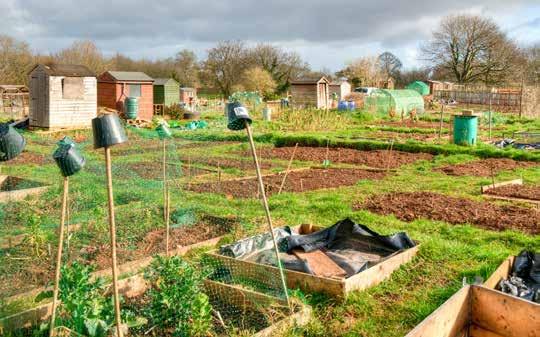



42 Don’t forget to mention Voice Magazines when responding to the Ads
IF YOU WOULD LIKE TO COME AND HAVE A LOOK, PLEASE GET IN TOUCH TO ARRANGE A SUITABLE TIME. JON TAYLOR ON 07591 333871
sales.
LEABROOKS ALLOTMENT-SHOP
225mm x 38mm Decking Shelves Raised beds Ideal for: Planters Tables Contact Kevin at KS Timber on 07919 273 909 SALE WAS £16 NOW £14! PROMPT DELIVERY • Heavy Duty Fencing • Wooden Gates • Landscaping • Security Fencing • Concrete Fencing • Hard & Soft Landscaping • Specialising in Maintenance free gardening • Artificial Grass Competitive Prices • Free Quotes & Measuring Service 07968 719 306 | 07966 497 848 enquiries@heanor-fencing.co.uk website: heanor-fencing.co.uk All Fencing Manufactured In-House & Installed To The Highest Standards QUALITY FENCING AT AFFORDABLE PRICES Open to Trade and Public Supply and Fit TOM C O OP E R Spe ci alist Tr ee Ca r e Servi c e s Tree Surgeon N PTC QUALI FIE D For a free, no obligation, quote call Tel: 0 1773 55 0002 or 07825 25 5 577 email tc.arb@hotmail.co.uk C ro w n re duc t ion • P r un i n g Fe llin g • H edge C u tt in g Garden Maintenance
x
Gardens








GARDENS To advertise please call the Voice Team on 01773 549 035 43 Licensed Waste Carrier DRB Waste Recycling Call Dale on 07581 450572 Household, garden, general building and waste metal removal. Household clearance and removals. Cost effective alternative to skip hire. Household Waste Clearance & Removals Metal Waste Garden Waste AVVM0862 (Dale Beuford Waste Recycling Q Advert).indd 1 ADVERTISING • DESIGN • DISTRIBUTION CONTACT US TODAY TO LEARN MORE! T: 01773 549035 | E: info@voicemagazines.co.uk www.voicemagazines.co.uk WE HAVE BEEN DELIVERING OUR COMMUNITY MAGAZINES SINCE 2010. We are committed to bringing you the best local businesses and community information. DON’T BE CURIOUS... ADVERTISE WITH
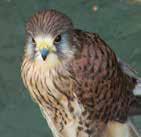
WATCHING THE ‘WINDHOVER’
Often mistakenly called a ‘hawk’, the kestrel or windhover is perhaps our most familiar bird of prey, and it is a falcon related to the diminutive merlin and the awesome peregrine. This was the bird of prey which seemed to survive the nadir of our raptors during the bad days of the 1950s to the 1980s. Ruthless persecution and use of persistent pesticides eradicated most birds of prey like common buzzards, sparrowhawks, peregrines, and red kites. These species hung on in the western parts of Great Britain but were largely extinct in and around the Peak District. The exception to this was the kestrel which seemed to quietly go about its business and was largely under the radar. This species also benefitted from the new motorways and dual carriageways which proliferated from the 1960s onwards and provided abundant verges full of mice and voles for kestrels to hunt. Indeed, it was in such places that most people became familiar with the windhover. They also adapted well to high-rise living in towns and cities and to disused or abandoned old quarries. In the absence of predation by or competition with the other raptors, the kestrel thrived, and along Peak District gritstone edges, it was possible to see ten or more birds in a single afternoon. However, in recent years it seems that the kestrel population has shrunk somewhat, and this may be because the other birds of prey have recovered


considerably and re-colonised the region in good numbers. Both common buzzard and peregrine falcon will compete for space and even predate the smaller kestrel, and so their numbers and distribution have now reduced. Indeed, the most frequently spotted birds of prey are probably sparrowhawk (a species which is certainly thriving), and common buzzard. The latter can be seen soaring over breeding sites with several birds in the air at any one time. The other coloniser is of course the spectacular red kite, though these still lag behind buzzards in the Peak. Another bird of prey yet to recolonise is the osprey which passes through on migration but as yet (I think) has not nested. Hopefully, the moorland hen harriers are starting to return, though peregrines still seem to do better in the urban areas than they do in the wild spaces of the Peak.
As numbers of these species continue to grow, there will be more competitive interactions between them, and with other potential rivals for space such as the raven. None of these birds likes its neighbours to be too close!

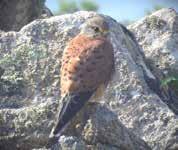


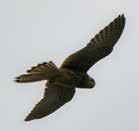

Professor Ian D. Rotherham, researcher, writer, broadcaster on wildlife and environmental issues in the Peak District and elsewhere, is contactable on ianonthewildside@ukeconet.org. Follow his website www.ukeconet.org, blog www.ianswalkonthewildside.wordpress.com/ & Twitter @IanThewildside
GARDENS 44 Don’t forget to mention Voice Magazines when responding to the Ads
NATURE NOTES FROM THE PEAK DISTRICT
KESTREL
FEMALE KESTREL AT SUNSET
KESTREL IN FLIGHT
KESTREL DROPPING KESTREL IN FLIGHT
KESTREL HOVERING
MALE KESTREL
YOUNG MALE KESTREL














You might think you’re doing them a favour, but it usually leads to floppy soft growth, which is more likely to collapse in rain or wind – not that we’re expecting this summer to have any of that! Staking is pretty important but don’t tie them in too closely, they need to bend with the wind but if you do lose stems, cut them back cleanly and you may get new growth below.
Prune philadelphus, forsythia and currant now they’ve finished flowering. They produce next year’s flowers on this year’s growth so pruning early gives more growth before winter.
If you want to lift this year’s tulips to clear beds or pots, wait till the foliage has turned yellow – generally about six to eight weeks after flowering. Cut off the stems, remove the foliage and leave the bulbs to dry then store in a paper bag somewhere dry and cool. Offsets –the little bulblets which grow alongside the main bulb can be pulled away, and treated as above then replanted in autumn about eight to ten inches deep. The main bulb can be planted around six inches deep in late autumn and even through until December or early January, although that display will be later.
GARDENS 46 Don’t forget to mention Voice Magazines when responding to the Ads T: 07832 953 612 HARRIS FENCING paulharrisfencing@gmail.com FENCING BESPOKE GATES TREE STUMP GRINDING/REMOVAL
contact Paul for a free no obligation quote! Find us on Facebook Harris Fencing Derbyshire AVVM1522 (Gardeners Calendar H Advert).indd 1 Cutting Edge Garden Services
aspects of garden maintenance
job too big or too small Good qualit y work at a competitive price All major tree works Seasonal tidy ups 01773 6 07737 07983 979755 For a FREE no obligation quote contact Phil on...
Please
All
No
Gardener’s Calendar Don’t overfeed your perennials. Top tip: Pinch out side-shoots on your toms. The aim is for the plant to concentrate on their fruit, not producing more leaves. Top Tip:
enquiries@hopkins-solicitors.co.uk
Managing your personal affairs is important
It’s all about finding a local expert that you can trust, that will keep your best interests at heart, whilst giving you straightforward advice.
No matter what twists and turns life throws at you, our legal team are here to help. But we are more than legal experts, we love to help people.
> Wills & Property Trust Wills
> Lasting Powers of Attorney
> Injury or Illness Claims
> Divorce or Children Matters
> Employment Advice
> Financial Disputes
Appointments by voice-call, video-call, in-person at one of our offices or if you are unable to leave the hospital our staff are happy to visit you at your bedside.


GARDENS To advertise please call the Voice Team on 01773 549 035 47 We have 6 convenient office locations in Mansfield, Sutton, Kirkby, Heanor and Nottingham. If you are bed or housebound, our staff are happy to meet with you at your home or in the hospital. Most of our departments offer a free initial telephone consultation.
01773 530 000
TO VISIT OUR WEBSITE
HIGHLY RECOMMENDED We have one of the highest client satisfaction rates in the country.
Scan











































GARDENS 48 Don’t forget to mention Voice Magazines when responding to the Ads
















































































































































































































































































